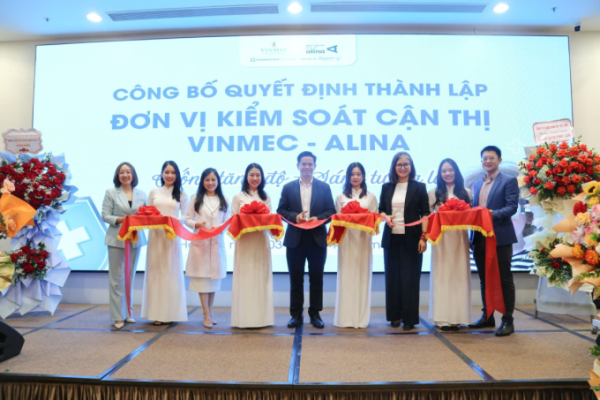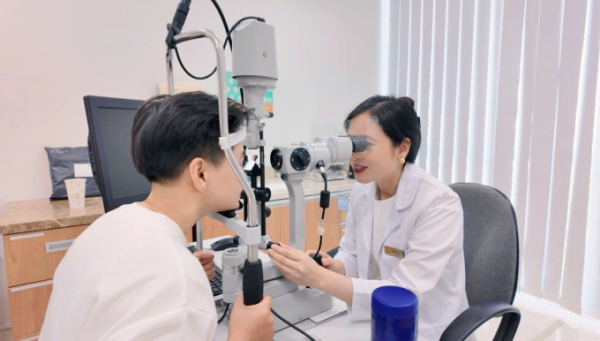
The facility, inaugurated to commemorate World Sight Day (Oct. 9, 2025), offers comprehensive and personalized eye care for children following international medical standards. It represents a strategic partnership between two leading medical institutions committed to advancing ophthalmology in Vietnam and protecting the eyesight of future generations.
|
Representatives from Vinmec Times City and Alina International Eye Hospital at the launch of the Vinmec-Alina International Myopia Control Unit at the signing ceremony. Photo courtesy of Alina International Eye Hospital |
According to the World Health Organization (WHO), nearly half of the global population will be nearsighted by 2050, with Vietnam among the fastest-growing nations. A 2024 report by the Vietnam Ophthalmological Society revealed that approximately five million Vietnamese children suffer from refractive errors, most of them myopic. In major cities like Hanoi and Ho Chi Minh City, the rate among students has exceeded 50%.
Specialists warn that myopia has become a silent epidemic in schools. Research shows that no degree of nearsightedness is harmless—each increase of one diopter raises the risk of serious eye diseases such as macular degeneration, retinal detachment, and even blindness by roughly 67%.
Experts emphasize that early intervention during the pre-myopia stage (below -0.5 diopter) can significantly slow progression. However, conventional eye exams and corrective glasses are no longer sufficient. Children require advanced assessments—such as axial length measurement, corneal curvature analysis, and individualized risk evaluations—to detect early signs and receive appropriate treatment.
“Myopia is no longer a cosmetic issue; it’s a public health concern,” said Dr. Tran Minh Ha, director of the Vinmec-Alina International Myopia Control Unit. “It threatens not only a child’s vision but also their learning and development. With modern science, we can intervene early to prevent worsening rather than merely correct vision. This center brings world-class solutions to safeguard the eyesight of future generations.”
|
Dr. Tran Minh Ha, director of the Vinmec-Alina International Myopia Control Unit, speaks at the inauguration ceremony. Photo courtesy of Alina International Eye Hospital |
The Vinmec-Alina Myopia Control Unit introduces a new model of international healthcare collaboration. It merges Vinmec’s expertise as one of Vietnam’s top private hospital systems with Alina International Eye Hospital’s specialized knowledge, which meets 100% of WHO’s surgical quality standards.
The initiative is supported by The Fred Hollows Foundation (Australia), TVM Capital Healthcare (Singapore), and Rohto Group (Japan)—all recognized leaders in advancing global eye health.
With the support of these international partners, the unit applies the latest evidence-based treatment protocols and technologies to elevate pediatric vision care standards in Vietnam. It also pioneers a cooperative model integrating medical excellence, research, and global best practices for local communities.
“This is not just a partnership between hospitals; it’s a shared mission to bring the world’s best eye care practices to Vietnamese children,” Ha said.
What sets the Vinmec-Alina Myopia Control Unit apart is its science-driven, comprehensive, and personalized approach to children’s eye health. Each child receives a customized treatment plan based on diagnostic protocols recommended by global authorities such as the International Myopia Institute, the World Council of Optometry, and the Brien Holden Vision Institute.
The center provides a full range of clinically proven and safe interventions, including orthokeratology (Ortho-K) lenses, soft contact lenses, myopia-control glasses, low-dose atropine eye drops, and red-light therapy.
 |
|
The Vinmec-Alina Control Unit applies international-standard diagnostic and treatment technologies to design personalized care plans for each child. Photo courtesy of Alina International Eye Hospital |
All ophthalmologists and optometrists at the unit are internationally certified in myopia management and have extensive experience treating pediatric and complex refractive cases. Children are monitored every six to twelve months, with detailed progress reports for parents. Advanced imaging systems and axial length tracking enable early detection of rapid progression.
The model also promotes collaboration between parents, schools, and primary care providers to foster eye-friendly environments and sustainable vision care habits.
Beyond treatment, the Vinmec-Alina Myopia Control Unit aims to build a national database on children’s eye health, standardizing measurements of axial length and refractive status. This data will provide a foundation for future public health programs and policymaking.
The center officially began operations in October 2025 at Vinmec Times City Hospital. Its first phase includes Vietnam’s largest-ever school vision screening campaign, covering 32,000 students aged 3 to 18 in Hanoi and Hung Yen Province. The program follows Massachusetts-standard school vision screening protocols from the U.S., incorporating both visual acuity and structural eye assessments.
The screening will identify early-stage myopia and create a detailed map of children’s eye health across regions, enabling more targeted interventions.
|
A doctor at the Vinmec-Alina International Myopia Control Unit consults with parents about personalized eye care plans for their child. Photo courtesy of Alina International Eye Hospital |
Parents can also access the free eBook “School Vision Care Handbook,” compiled by international eye specialists from the Vinmec-Alina unit. The guide offers practical advice on eye-friendly study habits, screen time management, and outdoor activity recommendations to help prevent myopia.
The launch of the Vinmec-Alina International Myopia Control Unit marks a significant milestone for pediatric ophthalmology in Vietnam. By integrating advanced technology, global partnerships, and medical expertise, it sets a new benchmark for managing and preventing childhood myopia.
Experts say the center’s integrated system—combining diagnosis, treatment, monitoring, and data management—could serve as a national model for vision health initiatives. It also reflects Vietnam’s growing capacity to adopt and localize international medical standards.
-
Varanasi court quashes plea against Rahul over remarks on Sikhs

-
Chrome Update: Google Chrome introduces the most useful feature, getting rid of unnecessary notifications..

-
TAC Infosec Shares Start Trading Ex-Bonus, Surge 5% After H1 PAT Doubles

-
Major supermarket issues 'do not steal' warning to its own staff

-
Tiger Woods told to retire as golf icon warned about long-term health effects
